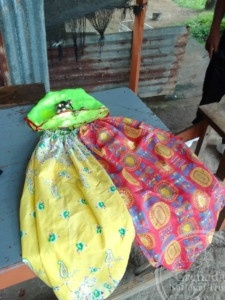Joshua Bartholomew 2022
The Short Knee is a distinctive masquerade whose members sing call and response songs composed by the band. Participants wear the same costume from head to toe with the exception of a unique headpiece expressing individuality. The components of the mas traditionally included starched headgear and a handmade face mask. The elder participants say the traditional headgear, called a head kerchief, was made to replicate an elephant, sheep, or goat head. This was achieved by manipulating cotton fabric starched with manioc into whatever shape the player desired (some people also used wax to enhance the effectiveness of the starch). Each headgear was unique. A white towel covering the head and pinned under the chin is also a part of the costume.
Currently, players use only the white towel as a headpiece, and this is kept in place with a headband made in the colour palette of the main costume. The costumes are made from brightly coloured fabric comprising baggy knickers (pantaloons), and a baggy top piece made with puffed sleeves which reach down to the player’s knees and are secured with elastic like the hem of the pants. This creates the puff sleeves or a kind of loose balloon effect with the whole costume. A neck bib with lace around the edge is a standard part of the costume and the colour of the bib signifies the band’s home village. Participants are required to wear the same colour shoes (sneakers), so that no one is distinguishable by their foot-gear. Willows (bells) are worn on the ankles to create a rhythmic sound effect as masquerades parade through the streets. The wearing of the same costume by all members signifies that the masquerade is one unit.
There is an element of secrecy regarding the costume which is further compounded with the wearing of a face mask to disguise the identity of the practitioners when the band is in pageant. The elder practitioners recall that, in the past, the anonymity of the players was important because of the potential for violent clashes involving the use of weapons. This was because the carnival period was used to settle old scores or deal with conflicts which flared up between rival villages during the period leading up to the annual event. This is less of an issue today.
The songs composed by the band can share a moral lesson, admonish individuals for behaviour that goes against accepted societal standards, or discuss events happening in the village or country. No topic is considered off-limits but, if songs are created about an individual in a particular village, the band would not sing that song in another village. While calling out folks, there’s still a responsibility to keep your business close and not make your people look bad in front of others.
Typically, the Short Knee masquerade is played during the annual carnival events held in Carriacou and Grenada in February and August, respectively. The bands play within their own parishes and clash with other bands from neighbouring villages or with bands from other parishes.
Chantimelle, Hermitage, River Sallee, Mt. Rich, Levera, and Samaritan in St. Patrick are all home to well-known Short Knee bands. Bands can also be found in the parish of St. Andrew, St John, and St. Mark.
The village of Chantimelle was a very popular band and notorious for violent clashes with neighbouring bands in times past. Elder practitioners remember Short Knee to be confrontational, like a “war”. Over the years, the element has changed from a men-only mas, to now include women and children. They were previously prohibited because of the potential for violent clashes during the expression.
Some well-known practitioners include Lionel Alexander (83) from St. Andrew who has been playing Short knee since the early 1960’s; Hennessey Jeffrey, now in his eighties, from the village of Chantimelle, St. Patrick who started playing Short Knee aged 14, and was Captain for his band; Hensley Jeffrey, son of Hennessey, and a teacher at St Patrick’s R.C. school; Andy Purcell (aka Lakay) (54) who has been playing Short Knee for 36 years and is the captain of the Hermitage Short Knee Band; Davis Richards (aka Kasa) (58) who has connections to the village of Chantimelle and has been playing Short Knee for 45 years; Frank Bartholomew of Tivoli, a Short Knee mask maker for the past 45 years, and former Captain of a Short Knee band and; Alister (aka Gaja) Thomas of Coast Guard, St. Mark, originally from Chantimelle and presently Captain of Coast Guard Short Knee.
There is evidence of intergenerational transmission as practitioners say they were influenced by a parent, sibling, or other close relative to take part and, consequently, all have been playing Short Knee for decades. Practitioners have varied accounts as to the origins of the mas in Grenada with links being made to Nigeria in Africa and others making the link to the emancipation of chattel slavery and the enslaved people’s expression of liberation. Some say Short Knee is an expression was a sign of protest.
Tailors who make the costume are integral to the mas and are expected to keep secret the colours chosen until the bands unveil them on the day of the pageant. Because of the level of confidentiality expected, some bands have a single tailor dedicated to sewing their costumes.
Mask makers are also integral to the overall expression of Short Knee. They have either been shown how to make the mask, or they are self-taught, simply by watching others.
By all accounts, only a few mask makers are known across the island and they supply masks to Short Knee practitioners at home and abroad. They are concerned about the lack of interest shown by the younger generation in taking up the skill, which they say is simple to learn. Mask makers are usually also practitioners of Short Knee.
With the exception of some of the composed songs having French patois words or phrases, the element is played out in English.

Mt.Rich Shortknee costume
Components of the masquerade include:
- The face mask.
- The costume which is made of an average of 6.5 yards of fabric to create the knickers (pantaloons) and a top with puffed sleeves adorned with a bib, overlapping to finish the look. It is made in such a way that it can give the appearance of a different costume when the back is worn as the front and vice versa. Nylon stockings complete the bulky look.
- The bib is ribbed (laced) with a contrasting colour and decorated with mirrors. The colour of the bib denotes the identity of the band. The bib is also referred to as the collar.
- Willows (bells) worn on the ankles are used to amplify the songs and chants.
- The conch shell was used in the past to communicate an attack. Nowadays, the shell is typically used to gather the group members.
- Talcum powder is a standard accessory and, depending on the band, has multiple uses. Some say it is used to excite the crowd, others say they use it to either thank spectators for contributions received, or to intimidate the crowd.
- Perfume was mentioned by one of the practitioners who said it is used for fragrance.
Mask makers are concerned about the lack of interest by young people in learning the craft. They often receive orders from the diaspora including Canada, the USA and England so this could be a financially lucrative venture for artists.
The Short Knee bands have a structure which is self-funding. Members pay for their own costumes and the Captain is responsible for transportation during the carnival season. The element is popular island-wide in Grenada and is also played during Carnival on the sister isle of Carriacou. Wherever there is a sizable Grenadian community in the diaspora, Short Knee is showcased – during Notting Hill Carnival in the UK, Caribana in Canada, and Labour Day in New York City.
For practitioners, a principal threat to the tradition is the cost to play Short Knee as opposed to the cost of playing Djab-Djab, which requires very little by way of costume. For this reason, more revelers are opting to play Djab-Djab.
Another threat to the element is the lack of interest shown in mask making. During enactments of the element in the diaspora, practitioners reach out to Grenada for their mask supplies, suggesting they are seeking authenticity. If the lack of interest in mask making is not addressed, the most likely scenario is that in time to come, that component may transition into a mass-produced mechanized process or disappear.
The scheduling of J’ouvert was cited as a possible threat to the showcasing of the element within the villages.
The prevailing issue appears to be funding of the element to make it more affordable for current practitioners to carry on playing and for new players to carry on the tradition.

Captain Chantuelle/Hennesy Jeffrey – Short Knee Interview
Photo Credit: Proud of my Heritage - ICH Team/Zone No.2



